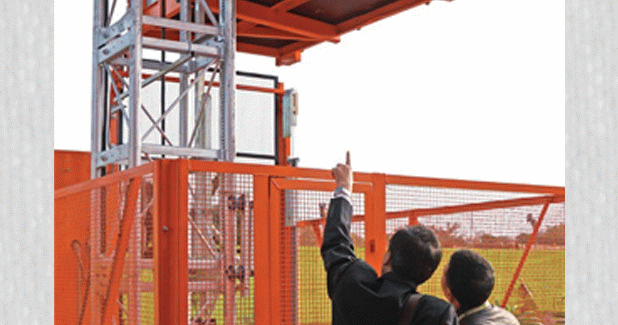
Safety in Construction Hoists
Construction hoist, popularly known as Passenger and Material (PM) Hoist, is used for transporting men and materials during high-rise construction vertically to heights up to 821 m - Burz Al Khalifa at Dubai is currently the tallest tower in the world and there are reports that Bechtel has been awarded an ambitious contract by Saudi Arabia to design a still taller tower. PM hoists are also used for other high rise applications like chimneys, shafts, cooling towers, nuclear and thermal power plants, pylons for suspended rope bridges and others. Similarly, India is also on a rapid path to high-rise construction and PM hoists are extensively used in our country.
GJJ Construction hoists are designed for 550 m height as standard with a speed of 46, 63, 96 and 120 m/min. Higher than 550 m height are also supplied according to specific building requirements. Therefore, GJJ adopts the highest safety standards and is proven all over the world.
Slowdown limits: These limits are provided to slowdown the cage before the upper and bottom cut-off to avoid jerk during stop. This is an important feature for any passenger hoist.
Up/down cut-off limit: These limits stop the cage at its upper and bottom end points and are set to match the cage floor with landing floor. This is a very important and critical passenger safety feature.
3-phase cut-off limit: In case the up/down cut-off limit did not function, then immediately the 3-phase power supply to the hoist will cut-off by this limit and will stop the cage. This is a mandatory safety feature.
Rack sensing limit: This is a very critical limit, which continuously senses the rack. In case the upper limit and 3-phase limit do not function or there is any break in the rack, this limit will stop the cage movement.
Enclosure door limit: The enclosure door also has a limit switch to ensure the safety of the people at ground level. If the enclosure door is not closed properly, the hoist cage will not move..
Cage door limit: This limit is for the safety of people inside the cage. If the cage doors (entry and exit) are not closed properly, then the cage cannot move.
Mechanical door interlocks: There is a mechanical cage interlocking with enclosure door. When the cage goes up, the enclosure door automatically locks. This is an important safety feature to avoid the entry of people under the cage when the cage goes up. This enclosure door can be opened, only when the cage reaches back to ground level.
Similarly, the entry door of the cage also has the mechanical interlock. Once the cage goes up, only exit door at opposite side can be opened. The entry door can only be opened when the cage reaches the ground level.
Centrifugal brake: This is a mandatory safety device to arrest the free fall of hoist cage due to any reason, including the brake failure, gearbox failure, pinion break, etc. This safety device is of high quality and must be replaced in every five years. GJJ has its own test facility where each hoist is tested with 125 per cent of its rated capacity.
This brake must be tested for free fall with 100 per cent load:
after commissioning, when mast height is changed, and in every six months. A wired remote control for testing is provided to enable the person stand outside the cage during the test.
Lock out brackets: These brackets are an additional safety feature to lock the cage with the mast in case all the above safety systems fail or there is a missing rack or pinion break. These brackets will ensure that the cage will not come out from the mast under any circumstance.
Buffer springs: Buffer springs are provided at ground level of the cage to safe guard the people in the cage, a mandatory safety feature.
Electromagnetic brakes:
The hoist motors are equipped with electromagnetic brakes. These brakes normally operate to stop the cage according to its operational requirement.
Overload device with load cells: This is a mandatory safety. This system gives an alarm at 90 per cent load and will cut off the cage movement if the load exceeds 100 per cent of its rated capacity.
Phase sequence relay: This is a mandatory safety. This relay ensures the right direction of rotation of motors as well as cuts off the system when high voltage, low voltage or a phase failure occurs.
Water and dust protection: GJJ adopts IP55 as standard for water and dust protection of electrical panels, motors and all electrical limit switches. This feature extends the life of the hoist and its electrical parts.
The author is Managing Director, Everest Engineering Equipment Pvt Ltd.


 +91-22-24193000
+91-22-24193000 Subscriber@ASAPPinfoGlobal.com
Subscriber@ASAPPinfoGlobal.com